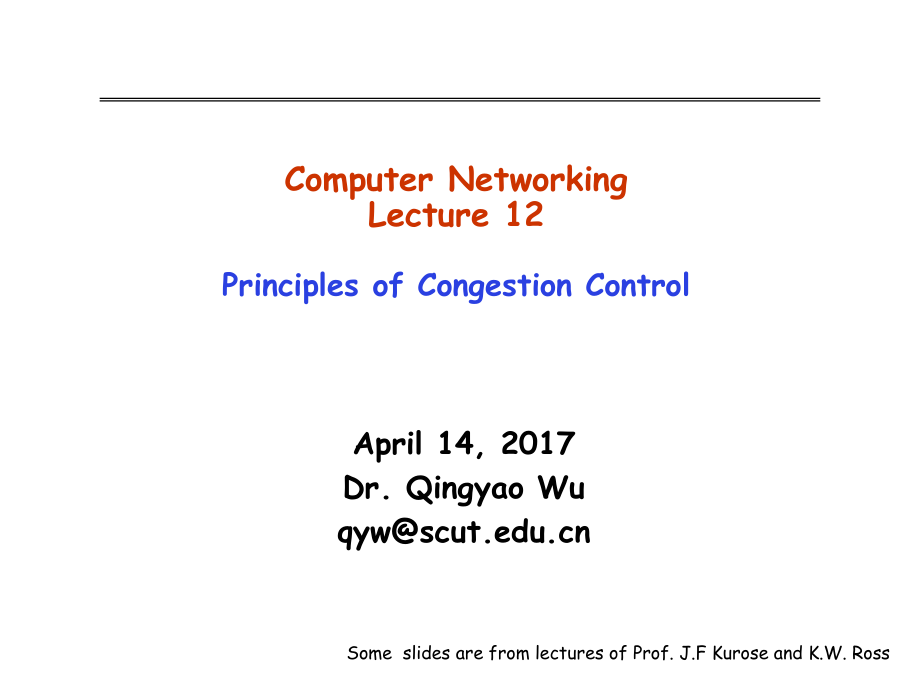 计算机网络英文课件:lecture-12- Congestion Control
计算机网络英文课件:lecture-12- Congestion Control



《计算机网络英文课件:lecture-12- Congestion Control》由会员分享,可在线阅读,更多相关《计算机网络英文课件:lecture-12- Congestion Control(27页珍藏版)》请在装配图网上搜索。
1、Computer Networking Lecture 12Principles of Congestion ControlApril 14,2017Dr.Qingyao WSome slides are from lectures of Prof.J.F Kurose and K.W.RossTransport Layer3-2Principles of Congestion ControlCongestion:informally:“too many sources sending too much data too fast for network to handle”different
2、 from flow control!manifestations:lost packets(buffer overflow at routers)long delays(queueing in router buffers)a top-10 problem!Transport Layer3-3Causes/costs of congestion:scenario 1 two senders,two receivers one router,infinite buffers no retransmission large delays when congested maximum achiev
3、able throughputunlimited shared output link buffersHost Alin:original dataHost BloutTransport Layer3-4Causes/costs of congestion:scenario 2 one router,finite buffers sender retransmission of lost packetfinite shared output link buffersHost Alin:original dataHost Bloutlin:original data,plus retransmi
4、tted dataTransport Layer3-5Causes/costs of congestion:scenario 2 always:(goodput)“perfect”retransmission only when loss:retransmission of delayed(not lost)packet makes larger(than perfect case)for samelinlout=linloutlinlout“costs”of congestion:rmore work(retrans)for given“goodput”runneeded retransmi
5、ssions:link carries multiple copies of pktR/2R/2linloutb.R/2R/2linlouta.R/2R/2linloutc.R/4R/3Transport Layer3-6Causes/costs of congestion:scenario 3 four sendersmultihop pathstimeout/retransmitlinQ:what happens as and increase?linfinite shared output link buffersHost Alin:original dataHost Bloutlin:
6、original data,plus retransmitted dataTransport Layer3-7Causes/costs of congestion:scenario 3 Another“cost”of congestion:rwhen packet dropped,any“upstream transmission capacity used for that packet was wasted!Host AHost BloutTransport Layer3-8Approaches towards congestion controlEnd-end congestion co
7、ntrol:no explicit feedback from networkcongestion inferred from end-system observed loss,delayapproach taken by TCPNetwork-assisted congestion control:routers provide feedback to end systems single bit indicating congestion(SNA,DECbit,TCP/IP ECN,ATM)explicit rate sender should send atTwo broad appro
8、aches towards congestion control:Transport Layer3-9Case study:ATM ABR congestion controlABR:available bit rate:“elastic service”if senders path“underloaded”:sender should use available bandwidthif senders path congested:sender throttled to minimum guaranteed rateRM(resource management)cells:sent by
9、sender,interspersed with data cellsbits in RM cell set by switches(“network-assisted”)NI bit:no increase in rate(mild congestion)CI bit:congestion indicationRM cells returned to sender by receiver,with bits intact Transport Layer3-10Case study:ATM ABR congestion control two-byte ER(explicit rate)fie
10、ld in RM cell congested switch may lower ER value in cell sender send rate thus maximum supportable rate on path EFCI bit in data cells:set to 1 in congested switch if data cell preceding RM cell has EFCI set,sender sets CI bit in returned RM cellTCP Congestion ControlTransport Layer3-12TCP Congesti
11、on Control sender limits transmission:LastByteSent-LastByteAcked CongWin Roughly,CongWin is dynamic,function of perceived network congestionHow does sender perceive congestion?loss event=timeout or 3 duplicate acks TCP sender reduces rate(CongWin)after loss eventrate=CongWin RTT Bytes/secTransport L
12、ayer3-14TCP Slow Start When connection begins,CongWin=1 MSS Example:MSS=500 bytes&RTT=200 msec initial rate=20 kbps available bandwidth may be MSS/RTT desirable to quickly ramp up to respectable raterWhen connection begins,increase rate exponentially fast until first loss eventTransport Layer3-15TCP
13、 Slow Start(more)When connection begins,increase rate exponentially until first loss event:double CongWin every RTT done by incrementing CongWin for every ACK received Summary:initial rate is slow but ramps up exponentially fastHost Aone segmentRTTHost Btimetwo segmentsfour segmentsTransport Layer3-
14、16TCP Congestion Avoidance Example:Transport Layer3-17RefinementQ:When should the exponential increase switch to linear?A:When CongWin gets to 1/2 of Threshold value before timeout.Implementation:Variable Threshold At loss event,Threshold is set to 1/2 of CongWin just before loss eventTransport Laye
15、r3-18Refinement:inferring loss After 3 dup ACKs:CongWin is cut in half window then grows linearly But after timeout event:CongWin instead set to 1 MSS;window then grows exponentially to a threshold,then grows linearlyq 3 dup ACKs indicates network capable of delivering some segmentsq timeout indicat
16、es a“more alarming”congestion scenarioPhilosophy:Transport Layer3-19TCP sender congestion controlStateEvent TCP Sender Action CommentarySlow Start(SS)ACK receipt for previously unacked data CongWin=CongWin+MSS,If(CongWin Threshold)set state to“Congestion Avoidance”Resulting in a doubling of CongWin
17、every RTTCongestionAvoidance(CA)ACK receipt for previously unacked dataCongWin=CongWin+MSS*(MSS/CongWin)Additive increase,resulting in increase of CongWin by 1 MSS every RTTSS or CALoss event detected by triple duplicate ACKThreshold=CongWin/2,CongWin=Threshold,Set state to“Congestion Avoidance”Fast
18、 recovery,implementing multiplicative decrease.CongWin will not drop below 1 MSS.SS or CATimeoutThreshold=CongWin/2,CongWin=1 MSS,Set state to“Slow Start”Enter slow startSS or CADuplicate ACKIncrement duplicate ACK count for segment being ackedCongWin and Threshold not changedTransport Layer3-20TCP
19、congestion control:additive increase,multiplicative decrease8 Kbytes16 Kbytes24 KbytestimecongestionwindowrApproach:increase transmission rate(window size),probing for usable bandwidth,until loss occursmadditive increase:increase CongWin by 1 MSS every RTT until loss detectedmmultiplicative decrease
20、:cut CongWin in half after loss timecongestion window sizeSaw toothbehavior:probingfor bandwidthTransport Layer3-21Summary:TCP Congestion Control When CongWin is below Threshold,sender in slow-start phase,window grows exponentially.When CongWin is above Threshold,sender is in congestion-avoidance ph
21、ase,window grows linearly.When a triple duplicate ACK occurs,Threshold set to CongWin/2 and CongWin set to Threshold.When timeout occurs,Threshold set to CongWin/2 and CongWin is set to 1 MSS.Transport Layer3-22TCP throughput Whats the average throughout of TCP as a function of window size and RTT?I
22、gnore slow start Let W be the window size when loss occurs.When window is W,throughput is W/RTT Just after loss,window drops to W/2,throughput to W/2RTT.Average throughout:0.75 W/RTTTransport Layer3-23TCP Futures:TCP over“long,fat pipes”Example:1500 byte segments,100ms RTT,want 10 Gbps throughput Re
23、quires window size W=83,333 in-flight segments Throughput in terms of loss rate:L=210-10 Wow New versions of TCP for high-speedLRTTMSS22.1Transport Layer3-24Fairness goal:if K TCP sessions share same bottleneck link of bandwidth R,each should have average rate of R/KTCP connection 1bottleneckrouterc
24、apacity RTCP connection 2TCP FairnessTransport Layer3-25Why is TCP fair?Two competing sessions:Additive increase gives slope of 1,as throughout increasesmultiplicative decrease decreases throughput proportionally RRequal bandwidth shareConnection 1 throughputConnection 2 throughputcongestion avoidan
25、ce:additive increaseloss:decrease window by factor of 2congestion avoidance:additive increaseloss:decrease window by factor of 2Transport Layer3-26Fairness(more)Fairness and UDP Multimedia apps often do not use TCP do not want rate throttled by congestion control Instead use UDP:pump audio/video at
26、constant rate,tolerate packet loss Research area:TCP friendlyFairness and parallel TCP connections nothing prevents app from opening parallel connections between 2 hosts.Web browsers do this Example:link of rate R supporting 9 connections;new app asks for 1 TCP,gets rate R/10 new app asks for 11 TCP
27、s,gets R/2!Transport Layer3-27Summary principles behind transport layer services:multiplexing,demultiplexing reliable data transfer flow control congestion control instantiation and implementation in the Internet UDP TCPNext:leaving the network“edge”(application,transport layers)into the network“core”
- 温馨提示:
1: 本站所有资源如无特殊说明,都需要本地电脑安装OFFICE2007和PDF阅读器。图纸软件为CAD,CAXA,PROE,UG,SolidWorks等.压缩文件请下载最新的WinRAR软件解压。
2: 本站的文档不包含任何第三方提供的附件图纸等,如果需要附件,请联系上传者。文件的所有权益归上传用户所有。
3.本站RAR压缩包中若带图纸,网页内容里面会有图纸预览,若没有图纸预览就没有图纸。
4. 未经权益所有人同意不得将文件中的内容挪作商业或盈利用途。
5. 装配图网仅提供信息存储空间,仅对用户上传内容的表现方式做保护处理,对用户上传分享的文档内容本身不做任何修改或编辑,并不能对任何下载内容负责。
6. 下载文件中如有侵权或不适当内容,请与我们联系,我们立即纠正。
7. 本站不保证下载资源的准确性、安全性和完整性, 同时也不承担用户因使用这些下载资源对自己和他人造成任何形式的伤害或损失。
